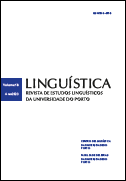Soap and water or water and soap? The difference a (still) human translator can make…
Abstract
The world of professional translation is inextricably linked to the conquests of artificial intelligence (AI), and human translators need to use machine translation tools and translation memories to increase their productivity. The aim of this paper is to highlight the importance of the human translator in the translation process and, consequently, to adapt the training of young translators to the circumstances in which they will have to work in the future. Based on the work of final-year students of FLUP's Master's in Translation and Language Services, we carried out an analysis of several cases that revealed the weaknesses of machine translation systems, in order to illustrate how human intervention can contribute to a more efficient translation process and a higher quality of the final product and can also help translators focus their efforts on areas where human intervention is most valuable. If the translator is aware of the limitations of AI systems in advance and if he/she knows what are the most appropriate linguistic resources applied in the different text genres of specialised communication in the target culture and language, during the revision and post-editing process he/she may focus his efforts on areas where human intervention is most valuable: in producing texts that do not look like a translation and reveal the characteristic features of original, specialised discourse in the target culture and language. By paying special attention to pronominal anaphora, collocations, idiomatic expressions, or macro- and micro-textual conventions translators can optimize the revision process, increase productivity, and achieve improved translations in less time.
References
Bacquelaine, F. (2020). Traduction humaine et traduction automatique du quantiƝcateur portugais «cada» en français et en anglais. Étude de phraséologie comparée. Tese de doutor amento.
Carmo, F. do. (2017). Post-editing: a theoretical and practical challenge for translation Studies and machine learning. [Disponível em: https://hdl.handle.net/10216/107518].
Forcada, M. L. (2010). Machine translation today. Gambier; Y. / Doorslaer, L. v. Handbook of Translation Studies. Volume 1. Amsterdão: John Benjamins Publishing Company: 215-223.
Göpferich, S. (1998). Textproduktion im Zeitalter der Globalisierung – Entwicklung einer Didaktik des Wissenstransfers. Studien zur Translation, Bd. 15. Tübingen: Stauffenburg.*|SIHULFK 62009. Comprehensibility Assessment using the Karlsruhe Comprehensibility Concept. The Journal of Specialized Translation 11.
Guimarães, J. (2012). Dar instruções: para uma gramática do texto de especialidade. Tese de Doutoramento apresentada à Faculdade de Letras da Universidade do Porto. [Disponível em https://repositorio-aberto.up.pt/handle/10216/67244 ].
Horn-Helf, B. (2007). Kulturdifferenz in Fachtextsortenkonventionen – Analyse und Translation. Ein Lehr- und Arbeitsbuch, Peter Lang.
Hu, K., & Cadwell, P. (2013). A Comparative Study of Post-Editing Guidelines. Baltic Journal of Modern Computing: 346-353.
Hutchins, J. (2010). Machine translation: a concise history. Journal of Translation Studies - Special Issue: The Teaching of Computer-Aided Translation, 13(1 & 2): 29–70.
Kalverkämper, H. (1978). Die Problematik von Fachsprache und Gemeinsprache. Sprachwissenschaft. 4/1978: 406-444.
Kay, M. (1997). The Proper Place of Men and Machines in Language Translation. Machine Translation, 12(1–2): 3–23.
Kenny, D. (Ed.) (2017). Human Issues in Translation Technology. London: Routledge.
Koponen, D. et al. (2020). Translation Revision and Post-editing: Industry Practices and Cognitive Processes. London: Routledge.
TAUS. (2016). Post-editing. Retrieved 15 March 2017, from https://www.taus.net/knowledgebase/index.php/Post-editing
Downloads
Published
Issue
Section
License
Copyright (c) 2024 Linguística: Revista de Estudos Linguísticos da Universidade do Porto

This work is licensed under a Creative Commons Attribution-NonCommercial 4.0 International License.



